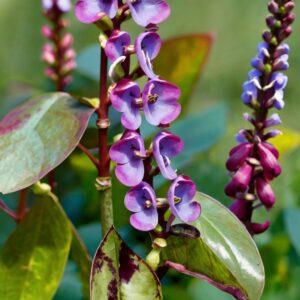
The Hyacinth Bean, scientifically known as *Lablab purpureus*, has an extensive and intriguing history that spans continents and centuries. Native to Africa, this vibrant plant is more than just a botanical specimen; it’s a symbol of cultural significance and a subject of folklore and historical literature. This investigative article delves into the journey of the Hyacinth Bean, its cultural roles, and its literary appearances.
The Origins and Historical Migration of the Hyacinth Bean
Native Roots in Africa
The Hyacinth Bean is believed to have originated in Africa, where it has been cultivated for thousands of years. Its resilience and versatility made it a staple in agricultural practices across various African regions. Early African communities recognized its nutritional value and its ability to thrive in diverse climates, from arid regions to more temperate zones.
Spread to Asia
From Africa, the Hyacinth Bean traveled to Asia, becoming particularly prominent in India. The spread of this plant can be attributed to ancient trade routes and the movements of early agrarian societies. In India, the Hyacinth Bean, known locally as “sem,” integrated seamlessly into agricultural and culinary traditions. The Indian subcontinent’s rich soil and favorable climate allowed the bean to flourish, making it a common ingredient in many traditional dishes.
Introduction to Europe and the Americas
European explorers and traders in the 15th and 16th centuries facilitated the Hyacinth Bean’s introduction to Europe. It became a part of European horticulture, valued not only for its edible beans but also for its ornamental flowers. The plant’s aesthetic appeal and ease of cultivation endeared it to European gardeners and botanists.
The journey continued to the Americas, where it was introduced by European settlers. In the United States, the Hyacinth Bean found a niche in both agriculture and ornamental gardening. Its adaptability to various climates allowed it to thrive across different states, from the southern to the northern regions.
Cultural Significance and Traditional Uses
Africa: A Nutritional Staple
In Africa, the Hyacinth Bean has been a crucial food source, especially in regions where other crops struggle to grow. The beans are rich in protein and fiber, making them a vital component of the local diet. They are often cooked in stews, soups, and porridges. The leaves and flowers are also edible and are used in various culinary preparations, adding nutritional diversity to the diet.
India: Culinary and Medicinal Uses
In India, the Hyacinth Bean holds a prominent place in both culinary and medicinal practices. The beans are used in a variety of dishes, such as curries, dals, and even pickles. The leaves are sometimes cooked as greens, while the flowers are used in traditional medicine to treat a range of ailments, including digestive issues and inflammation.
The plant also plays a role in Indian agriculture as a cover crop, helping to enrich the soil and improve crop yields. Its ability to fix nitrogen makes it a valuable addition to sustainable farming practices.
China: A Symbol of Beauty and Endurance
In China, the Hyacinth Bean is admired for its beauty as much as its utility. The plant’s delicate purple flowers and glossy green leaves are a common sight in Chinese gardens. Symbolically, the Hyacinth Bean represents endurance and resilience, qualities that resonate deeply in Chinese culture.
Europe: Ornamental and Functional
In Europe, the Hyacinth Bean has been cherished mainly as an ornamental plant. Its aesthetic appeal has made it a favorite in English and French gardens since the Renaissance period. In addition to its beauty, it has also been used as a food source during times of scarcity. European herbalists have documented its medicinal uses, although these practices are less common today.
Hyacinth Bean in Folklore and Historical Literature
The Hyacinth Bean’s journey through history is not only a tale of botanical migration but also one steeped in folklore and literary references.
African Folktales: A Symbol of Survival
In African folklore, the Hyacinth Bean often symbolizes survival and resilience. Stories tell of communities relying on the bean during times of drought and famine, highlighting its role as a life-sustaining plant. These tales underscore the bean’s importance in the collective memory and cultural heritage of African societies.
Indian Mythology and Literature
In Indian mythology, the Hyacinth Bean is sometimes associated with stories of resourcefulness and ingenuity. Ancient texts and folklore often mention the bean in the context of sustenance and health. Its medicinal properties are celebrated in Ayurvedic literature, where it is referred to as a remedy for various ailments.
Chinese Poetry and Symbolism
Chinese literature and poetry frequently reference the Hyacinth Bean. Poets have lauded its beauty and resilience, drawing parallels between the plant and human virtues. The bean’s ability to thrive in diverse conditions is often used as a metaphor for enduring hardships and emerging stronger.
European Literature: A Touch of Exoticism
In European literature, the Hyacinth Bean appears as a symbol of exotic beauty and mystery. During the Victorian era, the plant was a popular subject in botanical literature and garden manuals. Its introduction to Europe coincided with a period of fascination with exotic plants, and it was often described in terms that emphasized its foreign origins and unique appearance.

1 thought on “8 Ways Hyacinth Bean Shaped Cultures and History”